2004 CHEVROLET BLAZER tire size
[x] Cancel search: tire sizePage 343 of 446
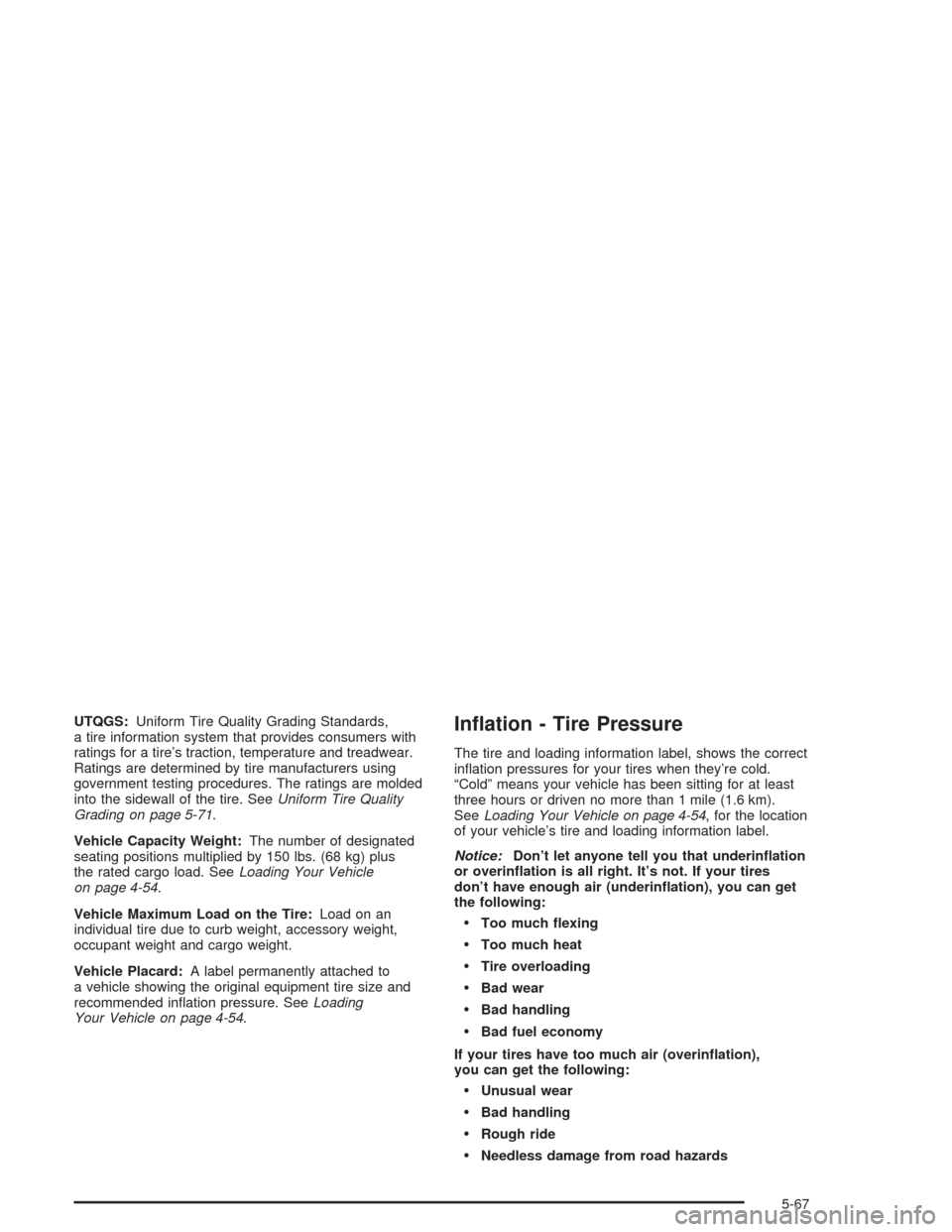
UTQGS:Uniform Tire Quality Grading Standards,
a tire information system that provides consumers with
ratings for a tire’s traction, temperature and treadwear.
Ratings are determined by tire manufacturers using
government testing procedures. The ratings are molded
into the sidewall of the tire. SeeUniform Tire Quality
Grading on page 5-71.
Vehicle Capacity Weight:The number of designated
seating positions multiplied by 150 lbs. (68 kg) plus
the rated cargo load. SeeLoading Your Vehicle
on page 4-54.
Vehicle Maximum Load on the Tire:Load on an
individual tire due to curb weight, accessory weight,
occupant weight and cargo weight.
Vehicle Placard:A label permanently attached to
a vehicle showing the original equipment tire size and
recommended in�ation pressure. SeeLoading
Your Vehicle on page 4-54.In�ation - Tire Pressure
The tire and loading information label, shows the correct
in�ation pressures for your tires when they’re cold.
“Cold” means your vehicle has been sitting for at least
three hours or driven no more than 1 mile (1.6 km).
SeeLoading Your Vehicle on page 4-54, for the location
of your vehicle’s tire and loading information label.
Notice:Don’t let anyone tell you that underin�ation
or overin�ation is all right. It’s not. If your tires
don’t have enough air (underin�ation), you can get
the following:
Too much �exing
Too much heat
Tire overloading
Bad wear
Bad handling
Bad fuel economy
If your tires have too much air (overin�ation),
you can get the following:
Unusual wear
Bad handling
Rough ride
Needless damage from road hazards
5-67
Page 345 of 446
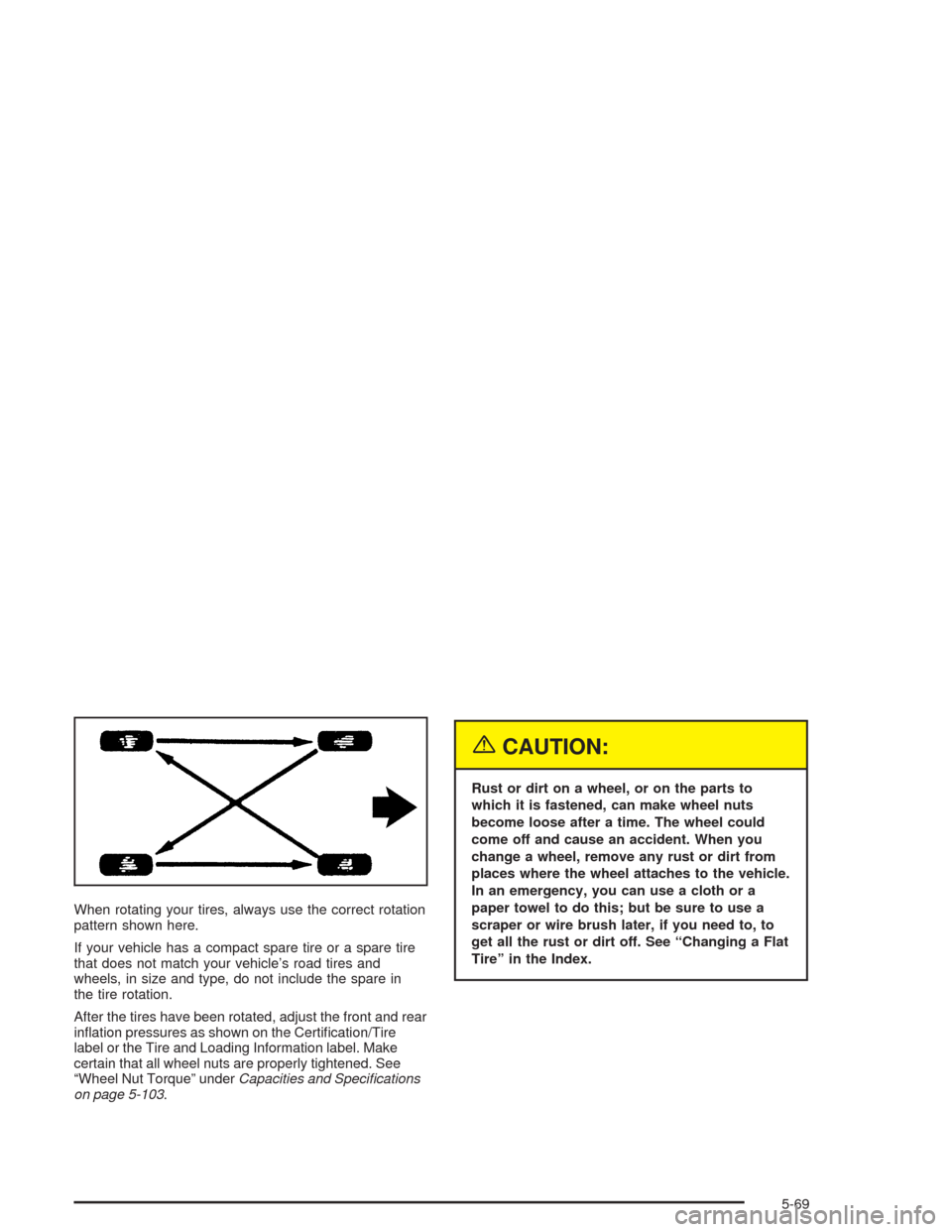
When rotating your tires, always use the correct rotation
pattern shown here.
If your vehicle has a compact spare tire or a spare tire
that does not match your vehicle’s road tires and
wheels, in size and type, do not include the spare in
the tire rotation.
After the tires have been rotated, adjust the front and rear
in�ation pressures as shown on the Certi�cation/Tire
label or the Tire and Loading Information label. Make
certain that all wheel nuts are properly tightened. See
“Wheel Nut Torque” underCapacities and Speci�cations
on page 5-103.
{CAUTION:
Rust or dirt on a wheel, or on the parts to
which it is fastened, can make wheel nuts
become loose after a time. The wheel could
come off and cause an accident. When you
change a wheel, remove any rust or dirt from
places where the wheel attaches to the vehicle.
In an emergency, you can use a cloth or a
paper towel to do this; but be sure to use a
scraper or wire brush later, if you need to, to
get all the rust or dirt off. See “Changing a Flat
Tire” in the Index.
5-69
Page 346 of 446
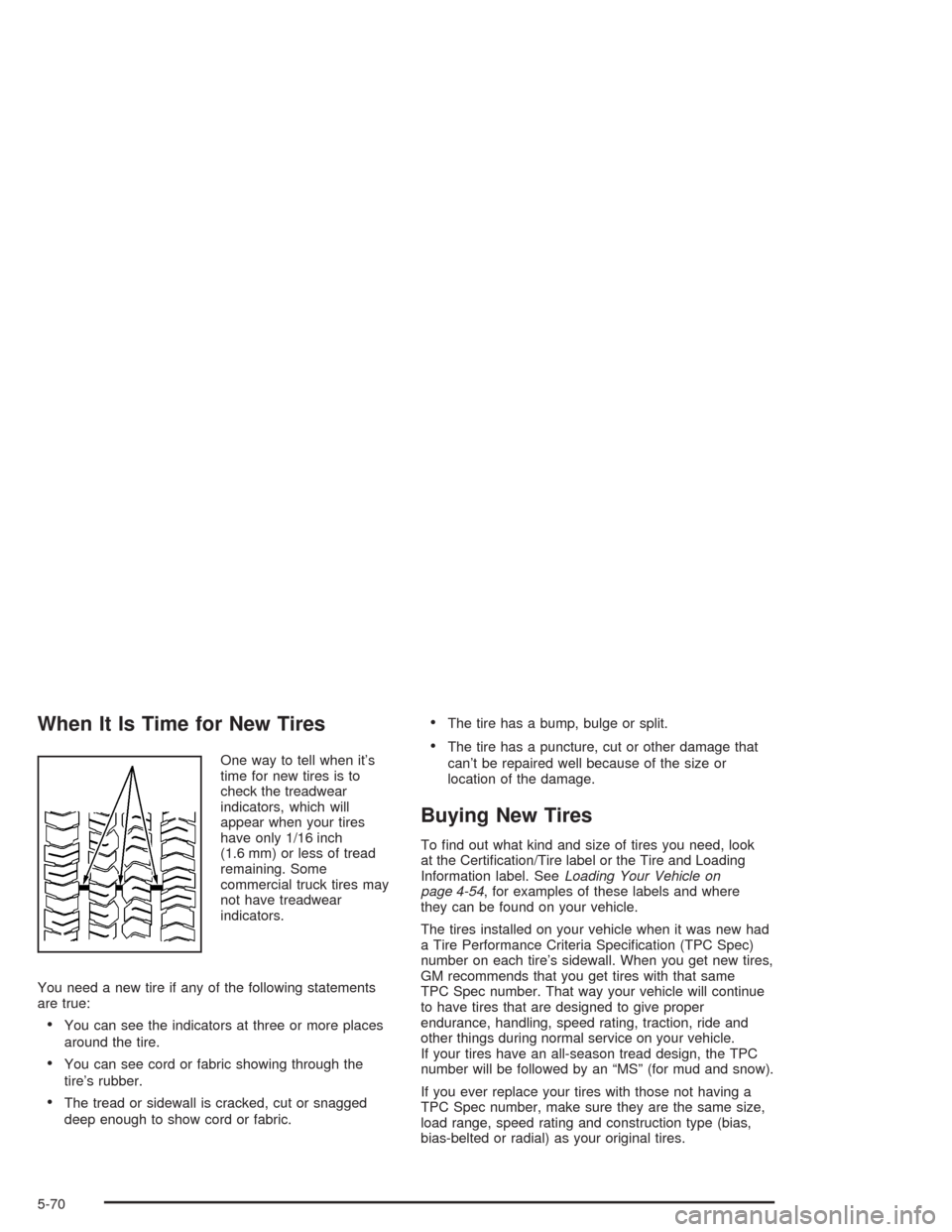
When It Is Time for New Tires
One way to tell when it’s
time for new tires is to
check the treadwear
indicators, which will
appear when your tires
have only 1/16 inch
(1.6 mm) or less of tread
remaining. Some
commercial truck tires may
not have treadwear
indicators.
You need a new tire if any of the following statements
are true:
You can see the indicators at three or more places
around the tire.
You can see cord or fabric showing through the
tire’s rubber.
The tread or sidewall is cracked, cut or snagged
deep enough to show cord or fabric.
The tire has a bump, bulge or split.
The tire has a puncture, cut or other damage that
can’t be repaired well because of the size or
location of the damage.
Buying New Tires
To �nd out what kind and size of tires you need, look
at the Certi�cation/Tire label or the Tire and Loading
Information label. SeeLoading Your Vehicle on
page 4-54, for examples of these labels and where
they can be found on your vehicle.
The tires installed on your vehicle when it was new had
a Tire Performance Criteria Speci�cation (TPC Spec)
number on each tire’s sidewall. When you get new tires,
GM recommends that you get tires with that same
TPC Spec number. That way your vehicle will continue
to have tires that are designed to give proper
endurance, handling, speed rating, traction, ride and
other things during normal service on your vehicle.
If your tires have an all-season tread design, the TPC
number will be followed by an “MS” (for mud and snow).
If you ever replace your tires with those not having a
TPC Spec number, make sure they are the same size,
load range, speed rating and construction type (bias,
bias-belted or radial) as your original tires.
5-70
Page 347 of 446
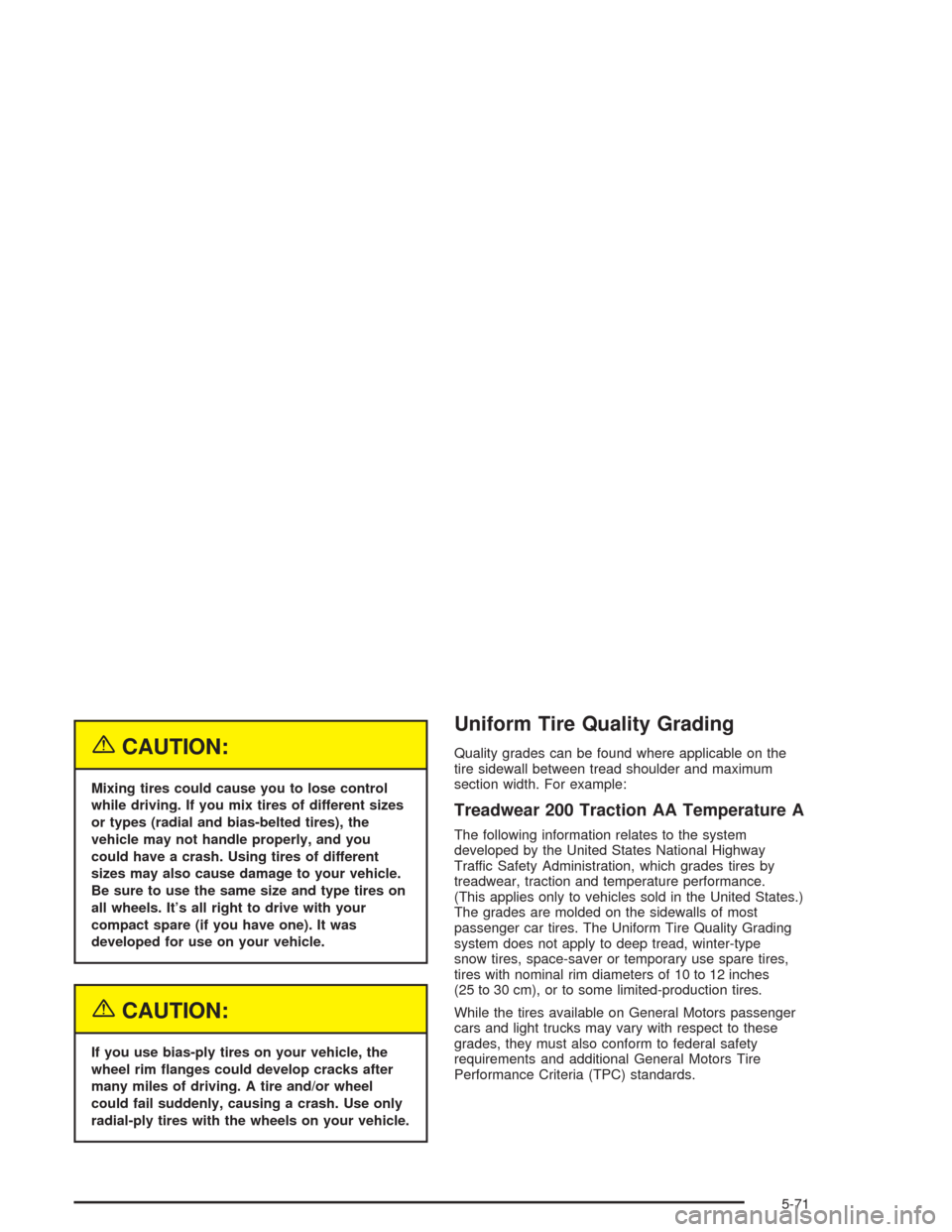
{CAUTION:
Mixing tires could cause you to lose control
while driving. If you mix tires of different sizes
or types (radial and bias-belted tires), the
vehicle may not handle properly, and you
could have a crash. Using tires of different
sizes may also cause damage to your vehicle.
Be sure to use the same size and type tires on
all wheels. It’s all right to drive with your
compact spare (if you have one). It was
developed for use on your vehicle.
{CAUTION:
If you use bias-ply tires on your vehicle, the
wheel rim �anges could develop cracks after
many miles of driving. A tire and/or wheel
could fail suddenly, causing a crash. Use only
radial-ply tires with the wheels on your vehicle.
Uniform Tire Quality Grading
Quality grades can be found where applicable on the
tire sidewall between tread shoulder and maximum
section width. For example:
Treadwear 200 Traction AA Temperature A
The following information relates to the system
developed by the United States National Highway
Traffic Safety Administration, which grades tires by
treadwear, traction and temperature performance.
(This applies only to vehicles sold in the United States.)
The grades are molded on the sidewalls of most
passenger car tires. The Uniform Tire Quality Grading
system does not apply to deep tread, winter-type
snow tires, space-saver or temporary use spare tires,
tires with nominal rim diameters of 10 to 12 inches
(25 to 30 cm), or to some limited-production tires.
While the tires available on General Motors passenger
cars and light trucks may vary with respect to these
grades, they must also conform to federal safety
requirements and additional General Motors Tire
Performance Criteria (TPC) standards.
5-71
Page 350 of 446
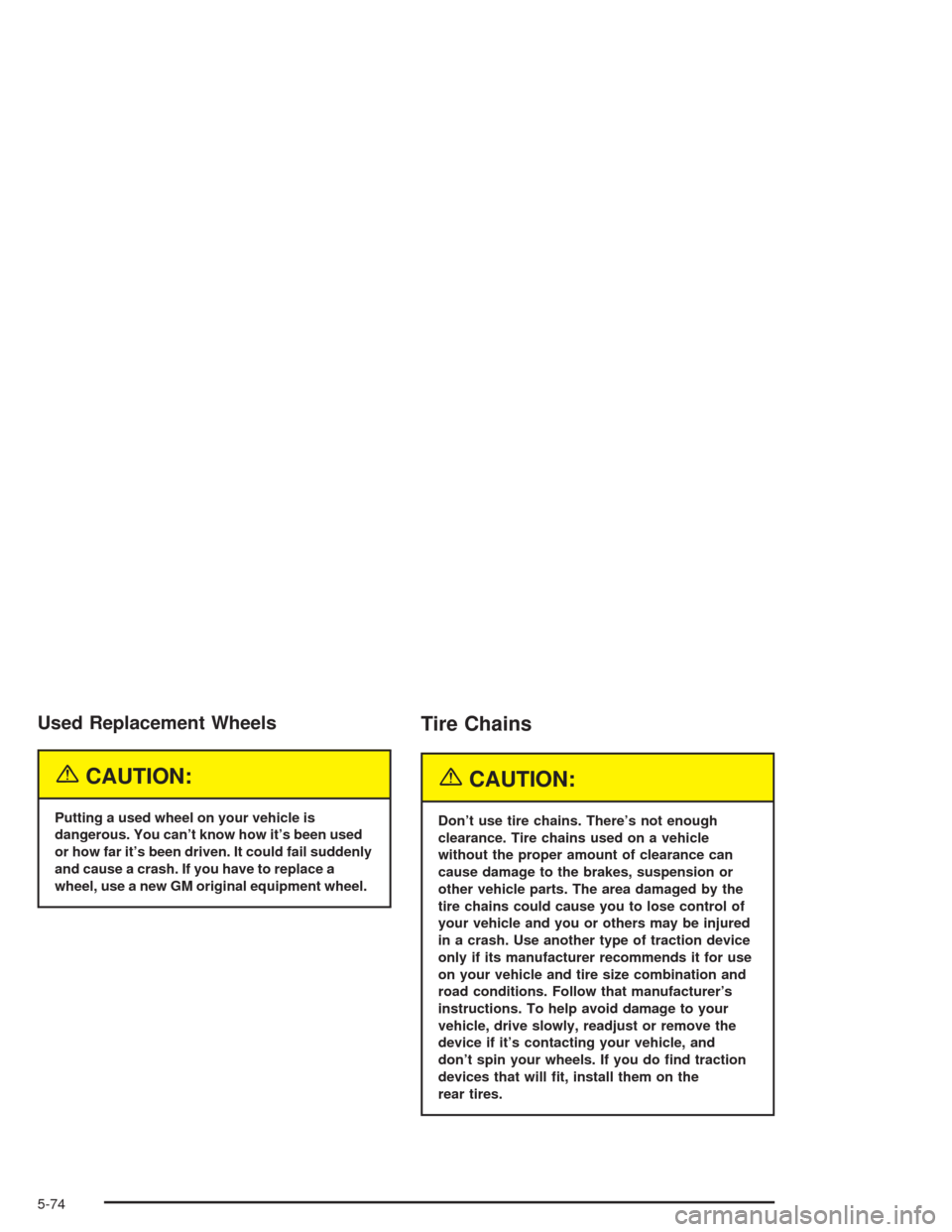
Used Replacement Wheels
{CAUTION:
Putting a used wheel on your vehicle is
dangerous. You can’t know how it’s been used
or how far it’s been driven. It could fail suddenly
and cause a crash. If you have to replace a
wheel, use a new GM original equipment wheel.
Tire Chains
{CAUTION:
Don’t use tire chains. There’s not enough
clearance. Tire chains used on a vehicle
without the proper amount of clearance can
cause damage to the brakes, suspension or
other vehicle parts. The area damaged by the
tire chains could cause you to lose control of
your vehicle and you or others may be injured
in a crash. Use another type of traction device
only if its manufacturer recommends it for use
on your vehicle and tire size combination and
road conditions. Follow that manufacturer’s
instructions. To help avoid damage to your
vehicle, drive slowly, readjust or remove the
device if it’s contacting your vehicle, and
don’t spin your wheels. If you do �nd traction
devices that will �t, install them on the
rear tires.
5-74
Page 365 of 446

Spare Tire
Your vehicle, when new, had a fully in�ated spare tire. A
spare tire, whether compact–size or full–size, may lose
air over time, so check its in�ation pressure regularly.
SeeIn�ation - Tire Pressure on page 5-67andLoading
Your Vehicle on page 4-54for information regarding
proper tire in�ation and loading your vehicle. For
instruction on how to remove, install or store a spare tire,
seeChanging a Flat Tire on page 5-76.
After installing the spare tire on your vehicle, you should
stop as soon as possible and make sure the spare is
correctly in�ated. Have the damaged or �at road tire
repaired or replaced as soon as you can and installed
back onto your vehicle. This way, a spare tire will be
available in case you need it again.
Don’t mix tires and wheels of different sizes, because
they won’t �t. Keep your spare tire and its wheel
together.
If your vehicle has the Xtreme™ Sport Appearance
Package (RPO V4A), the spare tire is smaller than your
vehicle’s original road tires, so don’t include the spare
in the tire rotation.
Appearance Care
Remember, cleaning products can be hazardous. Some
are toxic. Others can burst into �ames if you strike a
match or get them on a hot part of the vehicle. Some are
dangerous if you breathe their fumes in a closed space.
When you use anything from a container to clean your
vehicle, be sure to follow the manufacturer’s warnings
and instructions. And always open your doors or windows
when you are cleaning the inside.
Never use these to clean your vehicle:
Gasoline
Benzene
Naphtha
Carbon Tetrachloride
Acetone
Paint Thinner
Turpentine
Lacquer Thinner
Nail Polish Remover
They can all be hazardous — some more than
others — and they can all damage your vehicle, too.
5-89
Page 444 of 446

Storage Areas (cont.)
Front Storage Area......................................2-56
Glove Box..................................................2-49
Luggage Carrier..........................................2-57
Overhead Console.......................................2-49
Rear Convenience System............................2-60
Rear Storage Area.......................................2-59
Storing a Flat or Spare Tire and Tools...............5-85
Stuck in Sand, Mud, Ice or Snow......................4-44
Sun Visors.....................................................2-16
Sunglasses Storage Compartment.....................2-53
Sunroof.........................................................2-62
Swing-Out Windows........................................2-13
T
Tachometer....................................................3-24
Tailgate Release.............................................2-14
Tailgate-Mounted Spare...................................2-16
Taillamps.......................................................5-54
Temperature and Compass Display....................2-52
Testing the Alarm............................................2-17
Theft-Deterrent, Radio.....................................3-72
Theft-Deterrent Systems...................................2-16
Content Theft-Deterrent................................2-16
Passlock
®...................................................2-18
Throttle System Inspection...............................6-32
Tilt Wheel........................................................ 3-5
Time Delay....................................................2-43Tire In�ation Check.........................................6-26
Tire Sidewall Labeling......................................5-58
Tire Size.......................................................5-63
Tire Terminology and De�nitions........................5-64
Tires.............................................................5-57
Buying New Tires........................................5-70
Chains.......................................................5-74
Changing a Flat Tire....................................5-76
Compact Spare Tire.....................................5-88
If a Tire Goes Flat.......................................5-75
In�ation - Tire Pressure................................5-67
Inspection and Rotation................................5-68
Spare Tire..................................................5-89
Uniform Tire Quality Grading.........................5-71
Wheel Alignment and Tire Balance.................5-72
Wheel Replacement.....................................5-73
When It Is Time for New Tires......................5-70
Matching Transmitter(s) to Your Vehicle............... 2-6
To Use the Engine Coolant Heater....................2-22
Top Strap......................................................1-41
Top Strap Anchor Location...............................1-43
Torque Lock...................................................2-38
Total Weight on Your Vehicle’s Tires..................4-65
Tow/Haul Mode...............................................2-26
Tow/Haul Mode Light.......................................3-35
Towing
Recreational Vehicle.....................................4-46
Towing a Trailer..........................................4-60
Your Vehicle...............................................4-46
Trailer Brakes.................................................4-66
14